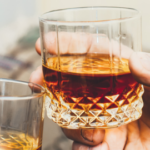The “world of whiskey” isn’t just a way to describe the sheer diversity of this spirit—it’s a nod to the fact that whiskey is produced in different ways around the world and even across the United States. However, the secret to enjoying a glass of whiskey is usually as simple as understanding exactly what you like. We’ll help you get a solid start by learning more about what makes them all unique in the first place.
These major types make up the vast majority of the whiskey you’ll find on the shelves of your local liquor store:
● Bourbon. This whiskey is one of the most popular spirits in the US, and for a good reason. However, there are rules surrounding bourbon whiskey—to be considered a bourbon, a whiskey must be produced in America from at least 51% corn mash, aged in a new oak barrel, and bottled at least 80 proof. Bourbons are usually smoother and sweeter than other types of whiskey and can feature vanilla or caramel notes.
● Tennessee whiskey. Tennessee whiskeys like Jack Daniels and other big names in whiskey often qualify as bourbons under the strict whiskey laws. However, Tennessee whiskey must also undergo charcoal filtration according to the “Lincoln County Process” before cask aging occurs.
● American whiskey. If a whiskey produced in America doesn’t qualify as a bourbon or Tennessee whiskey, it is likely produced using a blend of the two processes—or even a blend of multiple whiskey types. As a result, the characteristics of American whiskeys can vary wildly from brand to brand.
● Irish whiskey. Smooth in character, Irish whiskey is ideal for mixing, sipping on the rocks, or even neat. The process involves a mash of unmalted barley, triple distillation using only mash, water, and caramel coloring, and aging in wooden casks for at least three years.
● Scotch whisky. Scotch whisky (note the missing E) is usually referred to simply as “Scotch” and must undergo a very specific process dictated by Scottish law. It must be made in Scotland with malted barley and other grains, dried with peat moss smoke, and distilled in a copper still. Scotch is aged in oak barrels for at least three years and must be accompanied by an age statement so the drinker can characterize the whisky. Most Scotch is sipped on the rocks or neat.
● Canadian whisky. Similar to Scotch, Canadian whisky must age in barrels for at least three years. Due to a relatively high corn or rye content, however, many Canadian whiskies taste similar to American whiskeys and bourbons; others utilize wheat or barley. Most are suitable for sipping or mixing,
● Japanese whisky. One of the newest participants in the world of whiskey, Japan has begun crafting some excellent spirits in recent years. The country holds exceptionally high standards for all the whiskies it creates and has modeled its processes on the Scottish method of producing Scotch whisky. Not quite as complex as Scotch, but not as sweet as bourbon, Japanese whisky is an ideal whisky to sip or mix in cocktails of your choice.
Whether you prefer a sweeter bourbon produced right here in America or a nuanced Scotch crafted painstakingly over peat smoke, you’ll find quality examples of all the above varieties at your nearest Payless Liquors. Stop by and ask for a recommendation from one of our friendly sales staff, or reserve a bottle of the whiskey that’s right for you.
Resources:
Whisky beginners don’t fear – here’s how to pick the best whiskies to start












